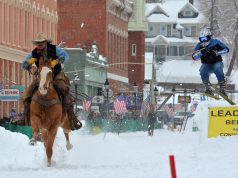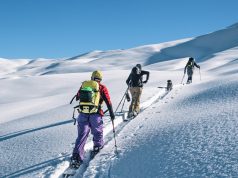
The air is still this Sunday morning. It’s fall and the hint of yellows and reds are starting to dot Boulder’s lush landscape — but it’s still warm. In fact, it’s already warm out on the plains east of the city on this particular Sunday morning, and with no clouds in the sky it’s obvious it’ll get a lot warmer. The heat doesn’t seem to bother Gary Campbell, though. He’s not worried about the time; he has all day. It’s a good day to be outside and, with miles and miles of visibility, an even better day to be flying. And it won’t be nearly so hot up at 10,000 feet.
Gary is one of a handful of members of the Soaring Society of Boulder (SSB) messing about with their gliders on this perfect morning. The society’s modest facilities are located on the north side of Boulder Municipal Airport. There’s a small building with walls covered by charts, weather information and other notices. It can hold about four people comfortably, which is why most of the folks here on this calm day sit outside at some adjacent picnic tables in the shade and talk flying.
Formed in 1959, the society is ground zero for all things gliders and soaring in Boulder County. The non-profit organization owns a couple of gliders and some tow planes, and features a membership of more than 170 people, including experienced instructors. The SSB was second in the U.S. in the Gold League, second in the U.S. in overall flights, and placed seven pilots in the top 100 nationally (when considering each pilot’s top six flights), with SSB member Bob Faris ranked fourth nationally, all flights considered. With world-class results and pilots, the group features a low-key, supportive environment that’s welcoming to newcomers regardless of whether you’ve piloted a glider or flown before.
“It’s a small community but a friendly one,” Campbell says, a retired engineer who got his start flying gliders after his wife gave him a seat in a tandem flight as a birthday gift.
“Gliders are different,” adds Campbell. “Powered flights are great for getting from point A to point B, for example, if you want to go have breakfast in Aspen. But what we do is take off and see what we can accomplish with Mother Nature. It’s a challenge to see how far you can go or how high you can get or how high you can stay up. It’s like a chess match, and that’s what’s fascinating about it and why you get a lot of scientists and engineers and similar types of people doing this — it’s challenging.”
According to Campbell, there are approximately 12,000-15,000 glider pilots in the United States; not a huge number, but nothing to sneeze at either. The community is small enough that fast friendships can easily be formed despite the solitary nature of flying. Annual meets, like the Soar Nephi Camps held in Nephi, Utah, bring the community together and offer the chance for competition, including “tasks” that challenge pilots to fly predetermined routes past “checkpoints” before returning to base. Pilots gain points based on how fast they accomplish the “task,” but there are other challenges, including time aloft and distance flown. And some of the distances are jaw-dropping, including an 809-kilometer (just over 503 miles) flight at a Nephi event in 2013.
Campbell admits that while he enjoys these events and participating in the “tasks” at gatherings like Nephi, he’s not competitive and the personal appeal for him is how flying gliders combines tranquility and beauty with the mental challenge of figuring out how to get the most out of Mother Nature. It’s a dance with the elements that rewards savvy pilots with spectacular flights that traverse the Front Range or travel across the Continental Divide, born only on the wind.
“We have guys who like to fly down to Taos and back,” Campbell says. “Or over to Steamboat and back. I’m a bit more conservative, though.”
Campbell’s conservatism comes from knowing that if things don’t work out, it can be a real headache.
“We have GPS and a lot of other instrumentation, so we have a lot of information on what should happen with the weather and flight conditions,” Campbell says. “We also know how far we can fly and what landing sites or airports we can reach at any given time. You don’t want to fly over to Steamboat and then have to land there because that’s going to be a long way for a pick-up.”
This, of course, is the big risk for glider pilots. With no power, they have to be savvy and aware and constantly ready to abort a flight if Mother Nature conspires against them. For Campbell this means that every time he closes the canopy on his plane, he has a detailed plan. It’s a twopart plan: the flying and soaring part, and then the moment when, if due to loss of altitude or other weather issues, he switches from flying mode to landing mode.
“When I switch to landing mode,” he says, “I am landing. I’m not hoping or thinking that I’ll fly some more and hope things work out, I am now in the mental state of looking for where I will land, and I will land. There’s no, ‘Well, I’ll keep on flying and see if it works out.’ I am heading down.”
This may sound risky or scary, but with soaring technology and the onboard instrumentation used by glider pilots, it’s rare that an airport or appropriate landing site is ever out of reach. High-performance gliders can fly vast distances easily and usually have a distance-to-drop ratio of more than 55 feet of horizontal travel to every loss of one foot of elevation. Campbell’s glider, an Alexander Schleicher ASW-1913, isn’t quite that impressive, but still returns a 38-to-one ratio, meaning that for every foot of elevation he loses, he can travel 38 feet forward, allowing ample flight time to return to base provided he’s remained inside the flight parameters that he’s set up for himself.
“Usually we fly between 14,000 and 18,000 feet as our altitude band,” Campbell says of the majority of the pilots that launch out of Boulder Municipal Airport. “Above 18,000 feet we come under the control of the [Federal Aviation Administration] where you are in commercial aircraft airspace — you have to file a flight plan and you are under direct control of [Denver International Airport].”
“We’re looking for lift, so we fly along the Front Range north to south. It’s a six or seven hour flight down to Taos and back, but I’m usually going up to Wyoming or above Estes Park. Wyoming and back is not a difficult flight, I enjoy the scenery, and I always want to come back,” he says with a laugh. “You always leave your keys in your car just in case you have to call someone to come and get you!”
While pick-up calls are rare, they do happen. Hence the fact that gliders are modular, with removable wings that stash next to the fuselage in a long trailer that is easily pulled by even a compact car, given the featherlight weight of the planes. Campbell’s glider clocks in (without the pilot) at just over 500 pounds and other planes are similarly svelte.
The weight-to-performance ratio is why Campbell admits that flying a glider is not for everyone. There’s no cart service, and while the cockpits are surprisingly comfortable, not a lot of extra space either.
“If you are claustrophobic it’s not ideal,” Campbell deadpans.
Still, it’s hard to argue with the simplicity and beauty that the experience offers. Today Campbell will get a “tug” (the term pilots use for a powerassisted glider launch) up to 8,000 feet and then will soar in an altitude band of 14,000-17,000 feet past Estes Park, back down to Idaho Springs and back to Carter Lake before returning to base. He’ll log a bit more than three hours of flight time and be home in plenty of time for dinner.
“Aspen [trees] are turning in the high country. Great view from up high,” he’ll report.
TAKE A FLIGHT: The Soaring Society of Boulder is a member-funded non-profit that is run out of Boulder Municipal Airport. Dedicated to supporting soaring, the organization has a variety of membership levels and provides basic facilities including five sailplanes, two tow planes, auxiliary equipment, training, and mutual assistance in assembling, launching and cross-country retrieves. You can learn more at soarboulder.org.














